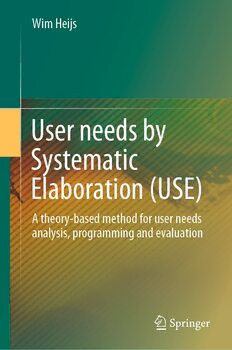Table Of ContentWim Heijs
User needs by
Systematic
Elaboration (USE)
A theory-based method for user needs
analysis, programming and evaluation
User needs by
Systematic
Elaboration (USE)
Wim Heijs
User needs by
Systematic
Elaboration (USE)
A theory-based method for user needs
analysis, programming and evaluation
WimHeijs
DepartmentoftheBuiltEnvironment,Real
EstateandUrbanDevelopmentGroup
EindhovenUniversityofTechnology
Eindhoven,TheNetherlands
ISBN 978-3-031-02051-3 ISBN 978-3-031-02052-0 (eBook)
https://doi.org/10.1007/978-3-031-02052-0
©TheEditor(s)(ifapplicable)andTheAuthor(s),underexclusivelicensetoSpringerNature
SwitzerlandAG2022
Thisworkissubjecttocopyright.AllrightsaresolelyandexclusivelylicensedbythePublisher,whether
thewholeorpartofthematerialisconcerned,specificallytherightsoftranslation,reprinting,reuse
ofillustrations,recitation,broadcasting,reproductiononmicrofilmsorinanyotherphysicalway,and
transmissionorinformationstorageandretrieval,electronicadaptation,computersoftware,orbysimilar
ordissimilarmethodologynowknownorhereafterdeveloped.
Theuseofgeneraldescriptivenames,registerednames,trademarks,servicemarks,etc.inthispublication
doesnotimply,evenintheabsenceofaspecificstatement,thatsuchnamesareexemptfromtherelevant
protectivelawsandregulationsandthereforefreeforgeneraluse.
Thepublisher,theauthorsandtheeditorsaresafetoassumethattheadviceandinformationinthisbook
arebelievedtobetrueandaccurateatthedateofpublication.Neitherthepublishernortheauthorsor
theeditorsgiveawarranty,expressedorimplied,withrespecttothematerialcontainedhereinorforany
errorsoromissionsthatmayhavebeenmade.Thepublisherremainsneutralwithregardtojurisdictional
claimsinpublishedmapsandinstitutionalaffiliations.
ThisSpringerimprintispublishedbytheregisteredcompanySpringerNatureSwitzerlandAG
Theregisteredcompanyaddressis:Gewerbestrasse11,6330Cham,Switzerland
Contents
1 Introduction ................................................... 1
1.1 ContextandMotivation ..................................... 1
1.2 PurposeandStructure ....................................... 6
References ..................................................... 7
2 DisciplinaryandMethodologicalBackground ..................... 9
2.1 DisciplinaryBackground .................................... 9
2.1.1 InformationProcessing ............................... 10
2.1.2 Affordances ......................................... 12
2.1.3 Mapping ............................................ 13
2.1.4 Person-EnvironmentFitandCongruence ................ 13
2.2 ApproachesandMethodsInvolvingUsers ...................... 14
2.2.1 SocialDesignandParticipatoryDesign ................. 15
2.2.2 BuildingPerformanceEvaluationandPerformance
BasedBuilding ...................................... 16
2.2.3 DesignConceptsinProductDevelopment ............... 17
References ..................................................... 18
3 PerspectiveandConceptualFramework .......................... 21
3.1 FunctionsofUSE .......................................... 21
3.2 TheNatureofUserNeeds ................................... 22
3.2.1 Complications ....................................... 22
3.2.2 ADifferentPerspective ............................... 25
3.3 TheNatureofDemands ..................................... 28
3.3.1 Complications ....................................... 29
3.3.2 ADifferentPerspective ............................... 30
3.4 TheNatureofEvaluation .................................... 34
3.4.1 Complications ....................................... 36
3.4.2 ADifferentPerspective ............................... 37
3.5 AParallelWorld ........................................... 42
References ..................................................... 43
v
vi Contents
4 Method ........................................................ 47
4.1 UserNeedsAnalysis ........................................ 47
4.1.1 Object .............................................. 47
4.1.2 UserGroups ......................................... 48
4.1.3 UserNeeds ......................................... 49
4.2 ProgramofDemands ....................................... 58
4.2.1 FunctionalDemands .................................. 58
4.2.2 FunctionalProgram .................................. 61
4.2.3 DesignReviewandDesign ............................ 62
4.3 Evaluation ................................................. 63
4.3.1 Preparation .......................................... 63
4.3.2 Analysis ............................................ 70
References ..................................................... 73
5 Application .................................................... 75
5.1 ProgramofDemands ....................................... 75
5.2 Evaluation ................................................. 80
5.3 OtherApplications ......................................... 83
References ..................................................... 85
6 Review ........................................................ 87
6.1 Comparison ............................................... 87
6.2 Future .................................................... 89
AppendixAInstruments ........................................... 91
AppendixBQuestionsandAssignments ............................. 107
AppendixCApplicationofUSEinProblemNeighborhoods ........... 121
Index ............................................................. 125
Chapter 1
Introduction
Abstract The design of a building can facilitate the process of use and promote
thewell-beingofitsusersifitmeetstheirneeds.Knowledgeoftheneedsofusers
and the process of use seems important for a good design. However, it is not self-
evident what these user needs really are,how user needs and processes of use can
beresearched,andhowthatknowledgecanbeusedtoimproveadesign.Thisbook
introducesatheory-basedmethodfortheanalysisofuserneedsandprocessesofuse,
andfortheapplicationoftheresultsinprogramsforbuildingdesignandinbuilding
management.Thefirstchaptercontainsanintroductiontothistopic.Itdiscussesthe
context and the reasons why it needs (more) attention. After this, the purpose and
structureofthebookareexplained.
· · · ·
Keywords Userneedsanalysis Processofuse Programming Buildingdesign
·
Postoccupancyevaluation Failurecosts
1.1 ContextandMotivation
We are usually not aware that a large part of our environment consists of objects
that are designed. This includes buildings, infrastructure, utensils and sometimes
seeminglynaturalphenomenasuchaslandscapes,riversorwoods.Mostly,thefact
thattheseobjectsaredesignedisnotobviouswhentheylookandperformasexpected.
Occasionally,adesignismoreconspicuous,especiallyifitisexceptionallybeautiful
oringenious,or,ontheotherhand,ifdesigndecisionshavebeenmadethatinterfere
with the expected appearance or process of use. The latter will not necessarily be
aproblem.Shortcomingsare,toacertainextent,tolerableandpeoplecanadaptto
suboptimal conditions. Nonetheless, as shown by the following examples, design
decisionscanhaveconsequencesthataremoreserious.
Case1.Governmentofficebuilding
After a major renovation, the office building at Rijnstraat 8 in The Hague was
reopened in 2017 to accommodate 6000 employees of 3 ministries of the Dutch
government(Fig.1.1).Forreasonsofefficiencyandofcostreduction,achoicewas
madeforopenspaceswith4400multifunctionalandflexibleworkplaces(about3200
©TheAuthor(s),underexclusivelicensetoSpringerNatureSwitzerlandAG2022 1
W.Heijs,UserneedsbySystematicElaboration(USE),
https://doi.org/10.1007/978-3-031-02052-0_1
2 1 Introduction
Fig.1.1 GovernmentofficebuildingRijnstraat8(MinisterieBZ2017)
desksandvariousotherspaces,suchasmeetingrooms,concentrationzonesandopen
areasforsocialinteraction).Afterthebuildingwasoccupied,anumberofproblems
emerged.AccordingtotheevaluationreportbyBeijeretal.(2018),thereappearsto
bealackofworkplaces:oftenemployeescannotfindaplacethatfitstheiractivities,
and when they leave the place for some time, they are inclined to claim it using
territorialmarkers.Thebuildingisverycrowdedwithqueuesattheentrance,toilets
andlifts.Thetightpositioningofworkplaces,movements,thenoiseandtheabsence
ofacousticbarriersinterferewiththeneedforconcentrationandforprivacyduring
meetingsorphonecalls.Thebuildinghasanimpersonalcharacterbothinsideand
out.Floorsandcorridorslooksimilarandsignsareoftenabsentorhardtoreadso
that wayfinding can be difficult. These and other problems (with furniture, indoor
climate,cleaningandmeansoflocatingcolleagues)causefeelingsofuneasinessand
tiredness among employees and reduce job satisfaction, cooperation and produc-
tivity.Accordingtoalateraudit,thefactthatuserswerenotinvolvedintheproject
(intime)isamajorcauseoftheproblems(Auditdienst2019).
Case2.Citydistrict
In the second half of the 1960s, the city of Amsterdam tried to counteract the
housing shortage by building a new district in the Bijlmermeerpolder. The project
wasbasedonthemodernistideasofurbandesign,withstrictseparationoffunctions
like working, living, recreation and traffic. High-rise blocks provided housing for
40,000familiesandlargegreenareasinbetweenweremeantforrecreation(Fig.1.2).
Elevatedroadsandparkinggarages,connectedtotheblocksbycoveredwalkways,
separatedcarsfrombikesandpedestriansonthegroundlevel.Thisshouldenhance
thewell-beingofresidentswithrespecttosafetyandcleanair.However,theseideas
1.1 ContextandMotivation 3
Fig.1.2 Bijlmermeerhigh-rise(Janericloebe2010)
didnotworkoutwell(Mentzel1989;Mingleetal.2019).Thelargedwellingswere
meanttoattractmiddle-classfamilies,butthosefamiliespreferreddetachedhouses
with a garden, the advantage of parking the car near their front door, and more
services and shops. As a result, the Bijlmermeer had a high vacancy rate. Rather
soon,dwellingswererentedouttolowerincomegroupsortheywereoccupiedby
squattersandillegalimmigrants.Thenumberofunemployedroseandthecrimerate
increased.Duetoalackofsocialcontrolinthegreenareasandwalkways,loitering
teens and junks caused much nuisance. Buildings and public spaces showed signs
ofvandalismanddilapidation,andtherewerestrongfeelingsofinsecurity.Toturn
thetide,ahugeinvestmentwasnecessary.High-riseblocksweretorndown,func-
tionsandtrafficmodesweremixedagainandtheamountofserviceswasincreased.
Currently,thedistricthasregainedcertainlivability.
Case3.Warninglight
In 1979, there was a partial meltdown of one of the reactors in the Three Mile
Island Nuclear Generating Station near Harrisburg (Fig. 1.3). This resulted in the
leakofradioactivegasesandiodineintotheenvironment(Wikipedia2019).Atfirst,
there were problems in the mechanical system during the cleaning of the water
filters. Accidentally a valve stayed open that should have been closed, which led
toaconsiderable leakage of nuclear reactor coolant. As aresult,the core partially
disintegrated. The operators could have dealt with this situation properly if they
wouldhavehadthecorrectinformation.However,awarninglight,thatshouldhave
beenontoshowthatthevalvewasopen,stayeddark,implyingthatthevalvewas
closed. Actually, the light did not indicate the position of the valve but the power
4 1 Introduction
Fig.1.3 ThreeMileIslandcontrolroomin1979(NRC2012)
status of the solenoid attached to the valve. The operators were not aware of this
ambiguityintheindicatorpanelandthusofthepossibilitythatthevalvemightstill
beopen.Consequently,theleakageofcoolantwasnotdetectedintime.Thisflawin
theuserinterfaceofthepowerplant,andaninsufficienttrainingoftheoperators,led
toseriousecologicalandhealthrisksandincreasedconcernsaboutnuclearenergy.
Thecleaningprocesslasteduntil1993andtookaboutonebilliondollars.
Theseexamplesshowthatsituationsinwhichadesignhasanundesirableeffect
can be quite diverse. This does not only concern old cases, but also more recent
ones,andtheycaninvolveverydifferentkindsofobjectsandscalelevels(buildings,
neighborhoodsoruserinterfaces).Theeffectscanbediverseaswell.Theremaybe
functionalconsequencesfortheprocessofuse(e.g.theefficiencyofwork),orphys-
ical influencesonone’shealth(radioactivegas),theuseofsenses(loudnoises)or
movements(standinginqueues).Socialeffectscanberevealed,forexample,byprob-
lemswithprivacyandwithsocialinteraction.Psychologicalinfluencescanbecome
manifest on a cognitive level (e.g. problems with wayfinding or problem solving)
or as emotions (such as feelings of insecurity). This can result in dissatisfaction
andareducedmentalwell-being.Inaddition,therecanbeeconomicconsequences.
These mainly consist of so-called failure costs, which are expenses for improving
thedesignandobjectorforrepairingthepossibledamage.Theremayalsobelegal
costsrelatedtoclaims,andlossesbecauseofreputationaldamage.Failurecostsare
likelytoexceedadditionalinvestmentsatanearlierstagetopreventtheseproblems.

